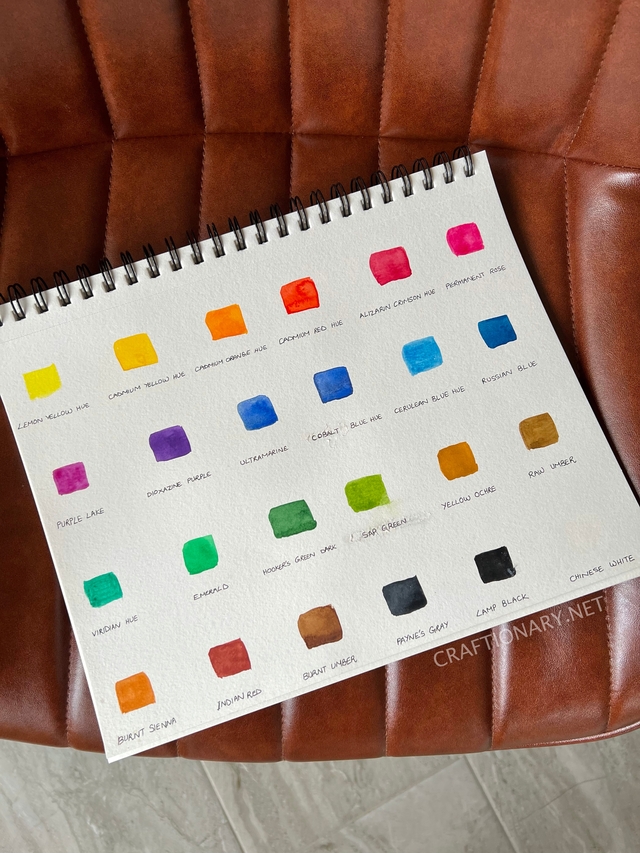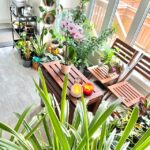This post may contain affiliate links. Please see our full Disclosure Policy for details.
Color blocking with watercolor paints. Watercolor is a very forgiving medium, which means it kind of flows on its own and it looks beautiful when it dries without much effort.
We will start by mixing colors to create a cool palette. Then we will create a design of rectangles and squares on varying sizes on our paper. Once our paint is dry we will add abstract geometric drawings on top of the color blocking with pens and gel markers.
You will love this art as it allows you to not worry about a perfect drawing or make something look exactly the same as something in the real world.
Some of the best crafting projects will keep you engaged in a fun process with less concentration on perfection and more focus on play and discover. Color blocking painting and art with watercolors and poscas is ideal for that purpose of crafts.
What is color blocking?
Color blocking is the art of using blocks and panels in contrasting colors. You can use solid bright colors with acrylic paints or beautifully flowing patterns of colors with watercolors.
Make your own Paint Brush Rest DIY and DIY Resin Coasters.
Color block watercolor painting with geometric patterns
You can have fun making this pattern on your book covers, wall art, sketchbook, and so much more!
Material:
To create this beautiful art you will need:
- Watercolor paper – the best is arches but I recommend good quality at reasonable price canson.
- Watercolors – you can buy watercolor half pans or watercolor tubes. Pans are ready to use and I like them for beginners. Tubes are long lasting and you will need a palette to keep them.
- Paint brushes – medium to small size flat brushes. However, I like to use round paintbrush size 8 for this project.
- Paper towel for dabbing brushes
- Water in a jar
- Paint palette – the above recommended set is ideal for beginners and comes with removable 2 palettes. Perfect for working anywhere.
- Posca markers – you can use any markers in black and white but I like posca because they don’t bleed and contain acrylic paint that gives rich results. You can also use black micron pens and white gel pens.
- Floating frame
How to choose a color combinations?
Sometimes it is hard to imagine how a color combination will look like just by looking at the watercoloring set you own.
I like to draw blocks of each color on a watercolor paper to get an idea of the final color when it dries on paper. This can also give you idea of how with more water this color radiates into lighter shades. You can have sample of shades as well will varying water amounts on paper as well.
Now you can block some colors and show some colors in your visual to see how they look together to decide your colors for this art. Use a blank white or black paper to remove them from vision and have fun playing this hide and seek game to discover different combinations.
Color blocking with watercolors
When you are working with watercolors to create color blocks you not only get fun colors but beautiful natural patterns that result from flow of color and water.
You do not need to know how to watercolor but any beginner can easily produce these results in creative ways.
We will discuss a variety of options:
– Wet-on-wet: This method involves wetting the paper with a water dipped paintbrush to create a block. You then dip your brush in paint and touch on the wet paper to allow the paint to flow into the water on paper.
– Wet-on-dry: This method allows you to use a watery pigment of watercolor that you produced on your palette and apply directly on the paper.
Tips for creating fun patterns and variations:
Don’t limit yourself when experimenting with color blocking. You can have fun in a variety of ways:
– Once you have colored your block wet your paintbrush and touch on the painted surface to create ripples. Let them flow freely and see the fun designs created.
– On a wet paper you can drop different colors or shades of color and it’s fun how they flow into each other creating fun abstract patterns.
– You can have fun creating designs by dropping some salt on wet paint and let it dry. Remove salt when the paint dries.
– You can add water to your brush and flow little paint on paper as well to make fun cloudy patterns.
– To make the color brighter you can always color over dried watercolors for more vibrant results.
Color blocking painting
I choose shades of blue and green with some earth tones for my pattern. You can have any combination that suits the space where you plan to display your art. You can also have separated blocks or connected blocks. There are so many ways to have fun.
You can mix different watercolors together to make variation of shades and work directly from the pan as well. When you take out paints on a palette and mix them with water the resulting colors are subtle and soft compared to the direct wet brush into paint which gives more intense results.
I have a video to guide you through the process and you will have fun following it along and making your art. Pause and work together.
We are going to create varying sizes of squares and rectangles and lay down color in different directions. Start from the left side if you are right-handed so that you don’t smear the paint as you go and vice versa if you are left-handed like me.
Color blocking design
Once your watercolors are fully dry, it’s time to have fun making geometric patterns. I am sharing a variety of different patterns from dots to spider webs and from simple lines to complicated diagonals.
The purpose is to share fun patterns and allow you to flow into making your own patterns. You can use a variety of designs or stick to a few as you like.
I like black and white brush pens as it allows my colors to stand out. However, you are not limited to using these colors only.
Use fun patterns like starburst, triangles, stripes, circles, swirls, randomly placed dots, scales, and even diamonds. Play around with different motifs and repeat them elsewhere to make the entire pattern look cohesive.
The video will guide you on how to create the patterns you see here. You can randomly draw these designs.
Color blocking walls ideas
There are so many fun uses for color blocking art and painting. Think small projects for hobby or when you are getting bored like notebook cover, scrapbooking, and a wall art.
On larger scale, you can create these patterns on a feature wall, furniture piece and even textile.
Print your handmade patterns to create a unique design that can be printed on mugs, fabric, and so much more to create unlimited possibilities.
I hope you enjoyed this project. I will see you soon with another fun project.
You will also like:
Wall art for living room thread painting DIY tutorial



















